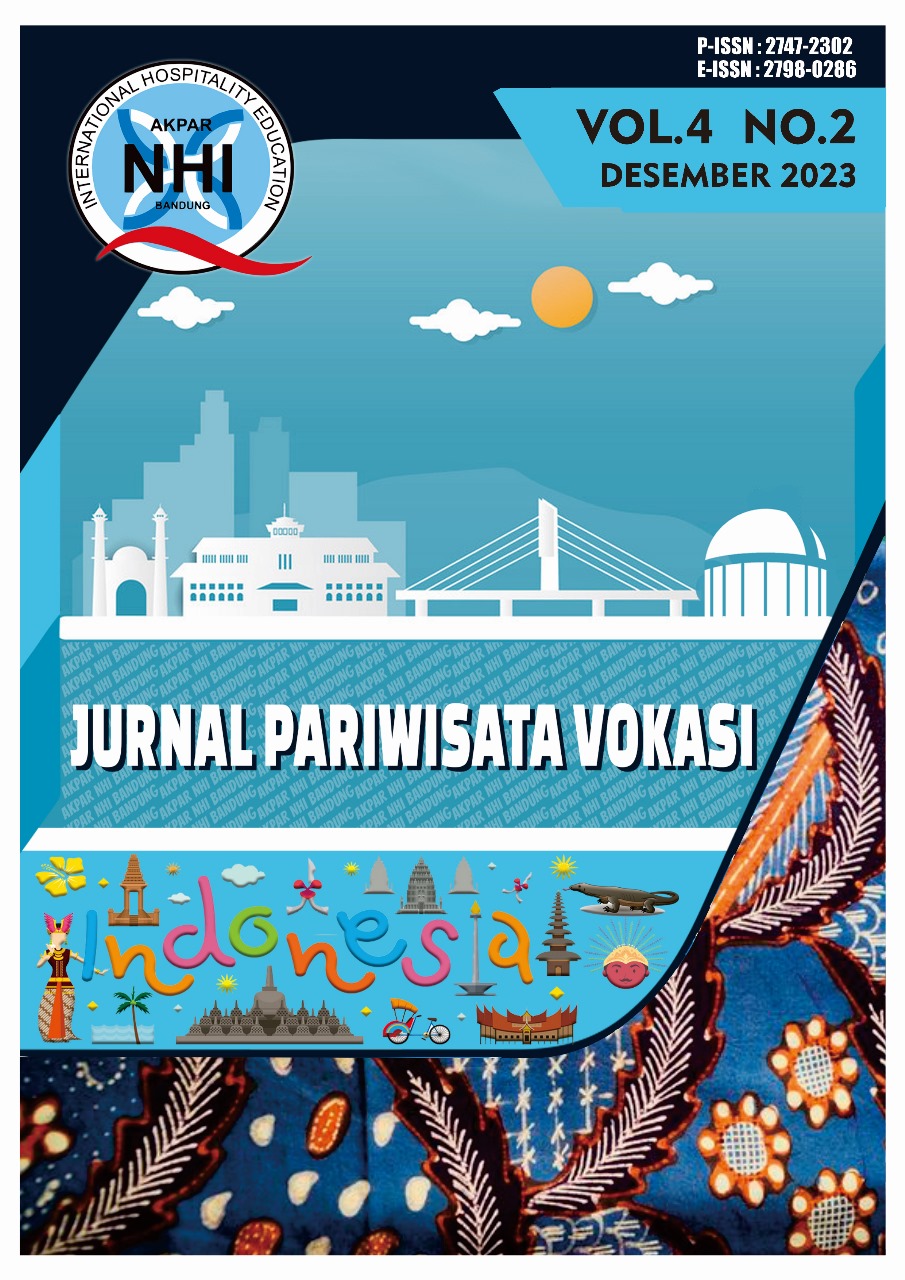PENGGUNAAN TEPUNG PATI GARUT DALAM PEMBUATAN NASTAR
DOI:
https://doi.org/10.60038/jpv.v4i2.89Keywords:
Tepung, Umbi Garut, NastarAbstract
This research aims to determine the differences in the taste of nastar made from arrowroot starch and comparison nastar, to find out the differences in nutritional content contained in the ingredients for making nastar made from arrowroot starch and comparison nastar, to find out the difference in the production costs of nastar made from arrowroot starch and comparative nastar, knowing the difference in the shelf life of nastar made from arrowroot starch and comparative nastar. The data collection technique used is by product experimentation, distributing questionnaires, observation. Meanwhile, the data analysis technique uses a Likert scale. The panelist research was carried out from 9 June 2023 to 13 June 2023, there were 30 untrained panelists and 10 trained panelists. From the assessment of trained panelists and untrained panelists on comparison pineapple and experimental pineapple, the results of the taste of each product were obtained. To determine the differences in color, aroma, texture and taste with the best composition of nastar which uses a percentage of arrowroot starch of 50% and 75%, an average of the panelists' assessment scores is required. Based on the data from the trained panelist assessment score table above for comparative nastar which was carried out on 10 trained panelists, the scores for each aspect can be seen, namely color, aroma, texture and taste. The author makes conclusions regarding the use of arrowroot starch in making nastar, as follows following: 1, Taste of Comparative Nastar and Experimental Nastar according to trained and untrained panelists regarding: a. Based on the data obtained regarding the color aspect, experimental pineapple A (50:50) was the most attractive compared to comparison nastar and experimental nastar B (75:25). b. Based on the data obtained regarding the aroma aspect, experimental nastar A (50:50) was the tastiest compared to comparison nastar and experimental nastar B (75:25). c. Based on the data obtained regarding the texture aspect, experimental nastar B (75:25) was crispier and softer than comparison nastar and experimental nastar A (50:50). d. Based on the data obtained regarding the taste aspect, experimental nastar B (75:25) was tastier than comparison nastar and experimental nastar A (50:50). Based on the comparison of nutritional content that has been discussed, comparison nastar and experimental nastar have almost the same number of calories, but comparison nastar has 74 lower carbohydrates than experimental nastar. while the experimental nastar had a lower amount of protein than the comparison nastar. The comparison nastar had lower production costs compared to experimental nastar A and experimental nastar B. The total production costs for making the comparison nastar were Rp. 20,271 while experimental nastar A was Rp. 22,230 and experimental nastar B was Rp. 23,209. The comparison nastar can be sold for Rp. 63,177, while the experimental nastar A can be sold for Rp. 68,075 and the experimental nastar B can be sold for Rp. 70,552. Based on the results of the pre-experiments carried out, the experimental nastar and the comparison nastar whose flour is roasted have the same shelf life. However, for nastar that is not roasted first, after about 1.5 months there is a change in the aroma aspect. To increase public interest in arrowroot starch flour, the suggestion given to solve the problem is that there needs to be a promotion regarding the use of local food ingredients to make nastar using arrowroot starch flour2. The use of arrowroot starch can be used as an alternative food ingredient to replace wheat flour, thereby reducing imports a.
References
Ayustaningwarno, Fitriyo.2014. Teknologi Pangan, Teori Praktis dan Aplikasi.
Cetakan 1. Yogyakarta:Graha Ilmu.
Dinpertan Pangan. Pengembangan Umbi Garut Sebagai Alternatif Pengganti Terigu Untuk Individual Autistik. Diakses dari https://dinpertanpangan.demakkab.go.id/?p=3490
Dispertan Banten. Umbi Garut, Pangan Alternatif yang Patut Dikembangkan. Diakses dari https://dispertan.bantenprov.go.id/lama/read/berita/307/Umbi- Garut-Pangan-Alternatif-yang-Patut-Dikembangkan.html .
Estiasih, Teti, Widya Dwi Rukmi Putri, dan Elook Waziiroh.2017.Umbi-umbian dan Pengolahannya. Cetakan 1.Malang:UB Press.
Gautama, Sarah Avilia. 2019. Pati atau Tepung?Jangan Salah kaprah!. Diakses dari https://student-activity.binus.ac.id/himfoodtech/2019/03/pati-atau-tepung- jangan-sala- kapra/#:~:text=Pati%20tampak%20seperti%20bubuk%20putih,flavor%20sert a%20teksturnya%20lebih%20kasar.
Indonesian chef assosiation.2020. Asal Usul Nastar dan Kastengel. Diakses dari https://indonesianchefassociation.com/article/content/cari-tahu-asal-usul-kue- nastar-dan-kastengel-yuk .
Inspirasi baking. 2021.Apakah harus sangrai tepung sebelum digunakan untuk membuat kue. Diakses dari https://inspirasibaking.com/apakah-harus-sangrai- tepung-terigu-sebelum-digunakan-untuk-membuat-kue/
Kahfi, Khairul.2022.BPS: Januari-November, Impor Gandum Indonesia 8,43 Juta Ton. Diakses dari https://validnews.id/ekonomi/bps-januarinovember-impor- gandum-indonesia-843-juta-ton
Kementrian Kesehatan RI. Data Komposisi Pangan Indonesia. Diakses dari https://www.panganku.org/id-ID/view
Kementrian Kesehatan. Konsep Dasar dan Sejarah Perkembangan Ilmu Gizi. Diakses dari https://yankes.kemkes.go.id/view_artikel/728/konsep-dasar-dan- sejarah-perkembangan-ilmu-gizi
Maulida, Wita. 2019. Boga Dasar. Malang: Quantum Book.
Risti, Yustisia, dan Arintina Rahayuni. 2013. Pengaruh Penambahan Telur terhadap Kadar Protein, Serat,Tingkat Kekenyalan dan Penerimaan Mie Basah Bebas Gluten Berbahan Baku Tepung Komposit.(Tepung Komposit:Tepung Mocaf, Tapioka dan Maizena). 2(4), 697.
Ronitawati, Putri. 2020. Modul Dasar-Dasar Kuliner.
Rosida,Dedin Finatsiyatull.2021.Pati Termodifikasi Dari Umbi-Umbian Lokal dan Aplikasinya Untuk Bahan Pangan. Surabaya:CV. Putra Media Nusantara.
Warawardhana, Deni dan Yuni Maharani, S.Ds, MT. indonesia Culinary center.
Jurnal Tingkat Sarjana Bidang Senirupa dan Desain.






